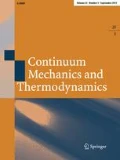Abstract
We show that the coupled balance equations for a large class of dissipative materials can be cast in the form of GENERIC (General Equations for Non-Equilibrium Reversible Irreversible Coupling). In dissipative solids (generalized standard materials), the state of a material point is described by dissipative internal variables in addition to the elastic deformation and the temperature. The framework GENERIC allows for an efficient derivation of thermodynamically consistent coupled field equations, while revealing additional underlying physical structures, like the role of the free energy as the driving potential for reversible effects and the role of the free entropy (Massieu potential) as the driving potential for dissipative effects. Applications to large and small-strain thermoplasticity are given. Moreover, for the quasistatic case, where the deformation can be statically eliminated, we derive a generalized gradient structure for the internal variable and the temperature with a reduced entropy as driving functional.
Similar content being viewed by others
References
Alber, H.-D.: Materials with Memory. Lecture Notes in Mathematics, vol. 1682. Springer, Berlin (1998)
Bartels S., Roubíček T.: Thermoviscoplasticity at small strains. Z. Angew. Math. Mech. (ZAMM) 88, 735–754 (2008)
Bartels, S., Roubíček, T.: Thermo-visco-elasticity with rate-independent plasticity in isotropic materials undergoing thermal expansion. Math. Model. Numer. Anal. (M2AN) (2010). Submitted (Preprint INS, Univ. Bonn)
Berdichevsky V.L.: Structure of equations of macrophysics. Phys. Rev. E 68, 066126 26 (2003)
Dzyaloshinskii I.E., Volovick G.E.: Poisson brackets in condensed matter physics. Ann. Phys. 125, 67–97 (1980)
Edwards B.J.: An analysis of single and double generator thermodynamics formalisms for the macroscopic description of complex fluids. J. Non-Equilib. Thermodyn. 23(4), 301–333 (1998)
Grmela, M.: Particle and bracket formulations of kinetic equations. In: Fluids and Plasmas: Geometry and Dynamics (Boulder, Colo., 1983), vol. 28. Contemp. Math. Am. Math. Soc. Providence, RI, pp. 125–132 (1984)
Grmela M.: Bracket formulation of dissipative time evolution equations. Phys. Lett. A 111(1–2), 36–40 (1985)
Grmela M.: Reciprocity relations in thermodynamics. Phys. A 309(3–4), 304–328 (2002)
Grmela M.: Why GENERIC?. J. Non-Newtonian Fluid Mech. 165, 980–986 (2010)
Grmela M., Öttinger H.C.: Dynamics and thermodynamics of complex fluids. I. Development of a general formalism. Phys. Rev. E (3) 56(6), 6620–6632 (1997)
Hackl K.: Generalized standard media and variational principles in classical and finite strain elastoplasticity. J. Mech. Phys. Solids 45(5), 667–688 (1997)
Hütter M., Tervoort T.A.: Finite anisotropic elasticity and material frame indifference from a nonequilibrium thermodynamics perspective. J. Non-Newtonian Fluid Mech. 152, 45–52 (2008)
Hütter M., Tervoort T.A.: Thermodynamic considerations on non-isothermal finite anisotropic elasto-viscoplasticity. J. Non-Newtonian Fluid Mech. 152, 53–65 (2008)
Kaufman A.: Dissipative Hamiltonian systems. Phys. Lett. A 100(8), 419–422 (1984)
Muschik W., Gümbel S., Kröger M., Öttinger H.: A simple example for comparing generic with rational non-equilibrium thermodynamics. Physica A 285, 448–466 (2000)
Mielke, A.: Hamiltonian and Lagrangian Flows on Center Manifolds. With Applications to Elliptic Variational Problems. Lecture Notes in Mathematics, vol. 1489. Springer, Berlin (1991)
Mielke A.: A mathematical framework for generalized standard materials in the rate-independent case. In: Helmig, R., Mielke, A., Wohlmuth, B.I. (eds) Multifield Problems in Solid and Fluid Mechanics, pp. 351–379. Springer, Berlin (2006)
Mielke, A.: A gradient structure for reaction-diffusion systems and for energy-drift-diffusion systems. Nonlinearity (2010). Submitted. WIAS preprint 1485
Mielke, A.: On thermodynamically consistent models and gradient structures for thermoplasticity. GAMM Mitt. (2010) Submitted
Morrison P.J.: A paradigm for joined Hamiltonian and dissipative systems. Phys. D 18(1–3), 410–419 (1986)
Öttinger H.C., Grmela M.: Dynamics and thermodynamics of complex fluids. II. Illustrations of a general formalism. Phys. Rev. E (3) 56(6), 6633–6655 (1997)
Öttinger H.C.: Beyond Equilibrium Thermodynamics. Wiley, New Jersey (2005)
Öttinger H.C.: Nonequilibrium thermodynamics for open systems. Phys. Rev. E (3) 73(3), 036126, 10 (2006)
Penrose O., Fife P.C.: Thermodynamically consistent models of phase-field type for the kinetics of phase transitions. Physica D 43(1), 44–62 (1990)
Penrose O., Fife P.C.: On the relation between the standard phase-field model and a “thermodynamically consistent” phase-field model. Physica D 69(1–2), 107–113 (1993)
Roubíček T.: Thermodynamics of rate independent processes in viscous solids at small strains. SIAM J. Math. Anal. 42, 256–297 (2010)
Sprekels J., Zheng S.M.: Global smooth solutions to a thermodynamically consistent model of phase-field type in higher space dimensions. J. Math. Anal. Appl. 176(1), 200–223 (1993)
Ziegler, H., Wehrli, C.: The derivation of constitutive relations from the free energy and the dissipation function. In: Advances in Applied Mechanics, vol. 25, pp. 183–237. Academic Press, Orlando, FL (1987)
Author information
Authors and Affiliations
Corresponding author
Additional information
Communicated by L. Truskinovsky.
Research partially supported by Deutsche Forschungsgemeinschaft within Matheon via the subproject C18 Analysis and numerics of multidimensional models for elastic phase transformations in shape-memory alloys.
Rights and permissions
About this article
Cite this article
Mielke, A. Formulation of thermoelastic dissipative material behavior using GENERIC. Continuum Mech. Thermodyn. 23, 233–256 (2011). https://doi.org/10.1007/s00161-010-0179-0
Received:
Accepted:
Published:
Issue Date:
DOI: https://doi.org/10.1007/s00161-010-0179-0
Keywords
- GENERIC
- Thermodynamic variables
- Thermoplasticity
- Thermoviscoelasticity
- Thermal coupling to elasticity and plasticity
- Energy-driven systems
- Entropy-driven systems
- Entropy-production potentials
- Generalized standard materials




